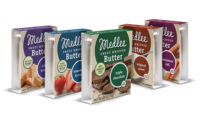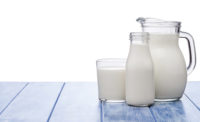The era of Greek yogurt cashing in big payouts has ended: The yogurt category has leveled off since the international style’s introduction to the U.S. market over a decade ago. In the 52-week period ending Aug. 11, 2019, yogurt’s dollar sales decreased 1.8% to $7,135.1 million, while unit sales fell 4.8%, according to data from Chicago-based market research firm IRI.
“With the Greek yogurt revival having run its course, yogurt and [smoothie] usage rates have dropped to 52%. Usage rates for cottage cheese, despite efforts to renew interest in this stalwart category through novel sweet and savory flavorings, [also] slipped to 49%,” states the Packaged Facts division of Rockville, Md.-based MarketResearch.com it its September 2019 “Eating Trends: Meat, Dairy, Vegetarian and Vegan” report.
Milk | Cheese | Cultured | Ice Cream | Butter | Non-dairy Beverages | Ingredients | Exports
While parts of the cultured dairy category — consisting of yogurt/skyr, sour cream, cottage cheese, cream cheese and kefir — aim for a consolation prize, some subsets look to split the pot. According to Packaged Facts’ “U.S. Food Market Report, 2019,” sales of yogurt drinks, for example, increased 13% from 2016 to 2018.
“Manufacturers are trying to revive demand with new products in both Greek and traditional segments, and launching more yogurt drinks, which have been growing,” the report notes.
Reviving interest in cultured dairy involves creating products that align with consumers’ many eating preferences, said Jorge Ramos, CEO, Dallas-based Lala U.S. Inc.
“We are seeing dairy firms such as ours more rapidly responding to changes in consumer demographics,” he continued. “That means firms need to provide more choices.”
Michael Neuwirth, senior director, external communications, Danone North America — based in White Plains, N.Y., and Broomfield, Colo. — concurred.
“Consumer needs are constantly evolving, and for companies and retailers to maintain a leadership position in cultured dairy, it’s critical to provide a comprehensive range of choices in the yogurt aisle that directly address consumer needs,” he noted.
Health claims have a blowout
One choice many U.S. consumers are making is to eat healthier. However, healthy means something different to every person, said Ramos, so cultured dairy processers need to provide options for a plethora of dietary preferences. This includes creating products with less sugar, more protein, higher fat content and other consumer-desired attributes.
Danone addressed customers’ desire for less sugar in cultured dairy by introducing its Two Good Greek low-fat yogurt. The product contains 2 grams of sugar per container — 80% less than conventional yogurt, said Neuwirth.
“Two Good is created using our patent-pending unique slow straining process that removes most of the naturally occurring sugar from milk, which in turn is used to make the yogurt,” he explained.
And Chobani LLC, Norwich, N.Y, said it released Chobani Greek yogurt with nut butters, which has more protein and less sugar than many other yogurts. The line includes Vanilla Greek yogurt with almond butter, Plain Greek yogurt with almond butter, Honey Greek yogurt with almond butter, Chocolate Greek yogurt with hazelnut butter and Vanilla Greek yogurt with cashew butter.
Meanwhile, Good Culture LLC., Irvine, Calif. added two offerings to its “Simply” category, which includes products that have a high protein content, less sugar and simple ingredients. The additions include high-protein Good Culture Simply Classic double-cream cottage cheese with 6% milkfat and Good Culture Simply sour cream.
For consumers looking for higher fat content, Prairie Farms Dairy, Edwardsville, Ill., added 6-ounce containers of whole-milk yogurt that come in Café Latte, Salted Caramel, Lemon and other varieties. More U.S. households are recognizing the many health benefits of whole-milk yogurt when making their purchasing decisions, Prairie Farms said.
Lifeway Foods Inc., Morton Grove, Ill., also introduced a whole-milk product: whole-milk kefir with real fruit. Each 32-ounce bottle is blended with full-fat milk and real fruit purée. The line is available in three flavors: Strawberry, Raspberry and Blueberry.
For some consumers, eating healthy means incorporating more probiotics into their diets. General Mills, Minneapolis, partnered with GoodBelly Probiotics — a brand of NextFoods, Boulder, Colo. — to launch a line of probiotics-containing lactose-free yogurts. The line comes in Wild Blueberry, Vanilla Bean, Peach, Coconut, Strawberry and Black Cherry flavors and contains over 1 billion live and active probiotics.
“We continue to innovate to expand our leadership position in the ‘simply better’ yogurt segment, which now makes up 11% of the category and generated high-teens retail sales growth last year,” said Jon Nudi, group president for North America, General Mills, in his remarks at the company’s 2020 Investor Day.
For its part, the Washington, D.C.-based International Dairy Foods Association (IDFA) is helping processors advertise the probiotic benefits of their products by working to revamp the Live and Active Cultures Seal program.
“This certification program provides a value-add for companies that choose to promote live and active culture yogurt and frozen yogurt using a dedicated seal on packaging and marketing materials,” said John Allan, vice president, regulatory affairs and international standards, IDFA.
Clean label yells ‘Bingo’!
Consumers also are seeking out brands that are naturally healthy, said Tasia Malakasis, CEO, Belle Chevre, Elkmont, Alaska. Many of today’s customers spend time researching products before purchasing them to make sure they meet clean-label standards. This might be good news for smaller craft brands that can promote the “naturalness” of their products.
“Amazing craft producers such as Belle Chevre are positioned to not only survive, but to thrive in cultured dairy because of this consumer demand,” Malakasis said.
This desire for transparency goes beyond the label, though, said Jesse Merill, founder and CEO, Good Culture. Customers are looking into company’s supply chains, too.
“[This] speaks to an important paradigm shift, as the consumer is increasingly looking for transparency in the supply chain and real/minimally processed foods,” he said. “Both have broad implications [for] health for our planet, people, farmers and animals and will hopefully lead to much-needed positive impact to our food system.”
Malakasis agreed, noting that today’s market demands more responsibility in production, including animal welfare and environmental stewardship.
“It is fascinating to watch producers give glimpses into the people and animals behind the products to those seeking some personalization of giant conglomerates,” she said. “They are doing this because we want to know who makes our food and how, and also why.”
International styles hit the jackpot
While Greek yogurt is no longer the product du jour, other international styles of cultured yogurt have gained popularity in the U.S. market. Some of the new varieties tout health claims, while others offer an indulgence factor.
For its part, Belle Chevre released a new line of goat milk-based cream cheeses made from a traditional French-style recipe. The offerings naturally have 2.5 times the protein of traditional cream cheese; are lower in fat, calories and lactose; and are free from any stabilizers, Malakasis said.
“I love watching the ‘old’ become new and cool again in cultured dairy — from Greek-style yogurt to innovations in cottage cheese to even European cream cheese style. I believe that we will see more of that in the market with innovations in product development,” she added, “with ‘ancient-to-modern’ offerings that also offer health benefits combined with expressive packaging suited for today’s consumer.”
Danone North America jumped on the international-style trend with its addition of Aussie Crème, an expansion of its Wallaby brand of organic Australian-style yogurts. The new line comes in three flavors: Spiced Peach, Strawberry Red Wine and Caramelized Pineapple. The yogurts are made with organic milk and premium organic ingredients, but are also crafted to be an indulgent experience by using 8.5% milkfat yogurt infused with a dulce de leche flavor.
And New York-based Icelandic Provisions added Krímí to its lineup of Icelandic-style skyr. The whole-milk offering comes in four flavors: Vanilla Bean, Strawberry-Rhubarb, Mixed Berry and Chocolate Coconut.
“We’re bringing a fresh approach to the whole-milk segment, which is currently dominated by either purely functional products that don’t taste great or products that are loaded with added sugar,” said Mark Alexander, CEO of Icelanic Provisisions. “While Krímí is certainly indulgent, it is ideal for the growing communities of people looking for a holistic approach to healthy eating.”
Brands catering to Hispanic audiences have also found success. Lala, for example, added Lala Crema Mexicana, a Mexican-style sour cream.
“We recognize the importance of the Hispanic population in the U.S., and we also understand that Lala is a relevant brand for them given its Hispanic heritage,” said Ramos. “We are leveraging this emotional link with the brand and are constantly developing products and innovation designed to cater to their specific needs.”
Convenience crosses out numbers
Many Americans are living busy lifestyles, and they’re turning to convenient meal or snack options that can be enjoyed on the go. Neuwirth said this has led to the development of new formats of yogurt such as drinks or bars.
Danone North America recently launched Oikos Pro Fuel, which is a protein-packed caffeinated cultured dairy beverage. It is available in Peach, Strawberry Banana, Vanilla and Mixed Berry flavors. Each 10-ounce bottle contains 25 grams of protein and 100 milligrams of caffeine from coffeeberry extract.
“The game-changing product blurs the lines between a few growing categories, including ready-to-drink coffee beverages and energy drinks,” Neuwirth said.
Many cultured dairy processors introduced yogurt smoothie products to appeal to consumers looking for nutritious meal replacements. Kraft Heinz Co., based in Pittsburgh and Chicago, added Fruitlove, a spoonable smoothie. Each cup of Fruitlove contains three or more real fruits and vegetables, provides a good source of protein and calcium, and is an excellent source of vitamins A, B1 and B3, the company said.
Fruitlove comes in five flavors, including Strawberry Banana Twirl, Harvest Berry Blend, Mango Medley, Pineapple Coconut Bliss and Blueberry Dream. It is packaged with a spoon for on-the-go snacking.
And Hiland Dairy Foods Co., Springfield, Mo., re-introduced and added more flavors to its Hiland Probiotic Yogurt Smoothies line. The smoothies come in Peach, Mango, Strawberry, Pecan Cereal, Piña Colada, Guanabana and Strawberry Banana flavors.
Kids’ yogurt cashes in
Products marketed toward children are a major part of the convenience market for cultured dairy.
“Today’s families need more nutritious, filling snack options to help fuel their on-the-go lifestyles,” said said Natalie Levine, brand director at Londonderry, N.H.-based Stonyfield Organic.
Stonyfield Organic expanded its kid-friendly Whole Milk Pouches and Snack Pack lines this year. The new Whole Milk Pouch flavors include Apple Cinnamon Sweet Potato and Blueberry Apple Carrot. They are made with real fruit and vegetables and have 35% less sugar than the leading kids’ yogurt, Stonyfield Organic said.
The flavor additions to the Stonyfield Organic Snack Pack line are Vanilla Low-fat Yogurt & Chocolate Cookie, Strawberry Low-fat Yogurt & Chocolate Cookie, Classic Yogurt Hummus & Multigrain Tortilla Chip, Roasted Red Pepper Yogurt Hummus & Pretzel and Garlic Yogurt Hummus & Pretzel.
According to the company, the product additions are in line with the macro trends seen in the kids’ snacking market, which are predicted to grow steadily as today’s health-minded millennial parents increasingly demand more nutrient-dense snacking options meant to serve as “mini-meals.”
Ingenuity Brands, San Francisco, took it a step further with its launch of Brainiac Kids, the first line of kids’ yogurts specifically targeted to help developing brains. The whole-milk yogurts are enhanced with a blend of nutrients, including omega-3s docosahexaenoic acid and alpha-linolenic acid, as well as choline, which support childhood brain development, the company said.
“Our kids’ brains continue to develop after those first critical 1,000 days — and we need good, kid-friendly foods to nurture developing brains throughout their childhood and teen years,” said Jonathan Wolfson, founder and CEO of Ingenuity Brands. “These nutritional challenges presented an opportunity to create a food brand from the ground up, focused on brain nutrition and launched with yogurts that are not only delicious and fun for kids, but also help to feed their brains and close the nutrient gap.”
Braniac Kids was created with input from parents, pediatricians, nutrition scientists and neurologists. The brand’s products are available in Strawberry Banana, Strawberry, Mixed Berry and Cherry Vanilla flavors.
“As a parent of three, I know how hard it is to get kids to eat good sources of these nutrients — like salmon and broccoli — which is why Brainiac Kids is so exciting to me,” said Mark Brooks, cofounder and president of Ingenuity Brands. “It’s a whole food that kids will love and parents can feel good about, as it helps every child get the brain nutrients they need to reach their full potential.”
Milk | Cheese | Cultured | Ice Cream | Butter | Non-dairy Beverages | Ingredients | Exports








